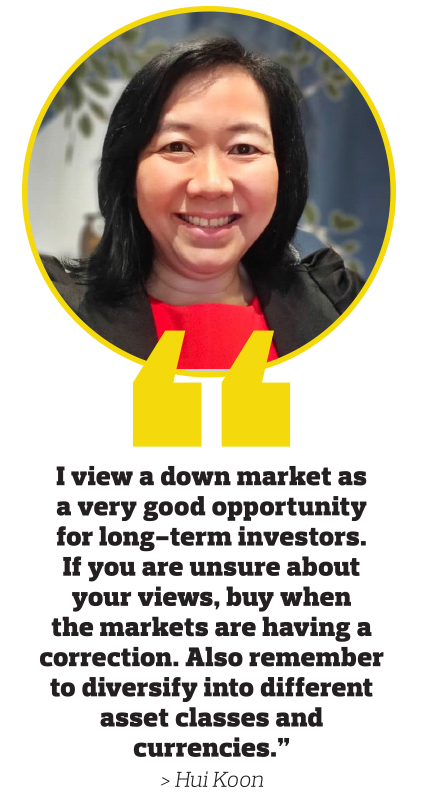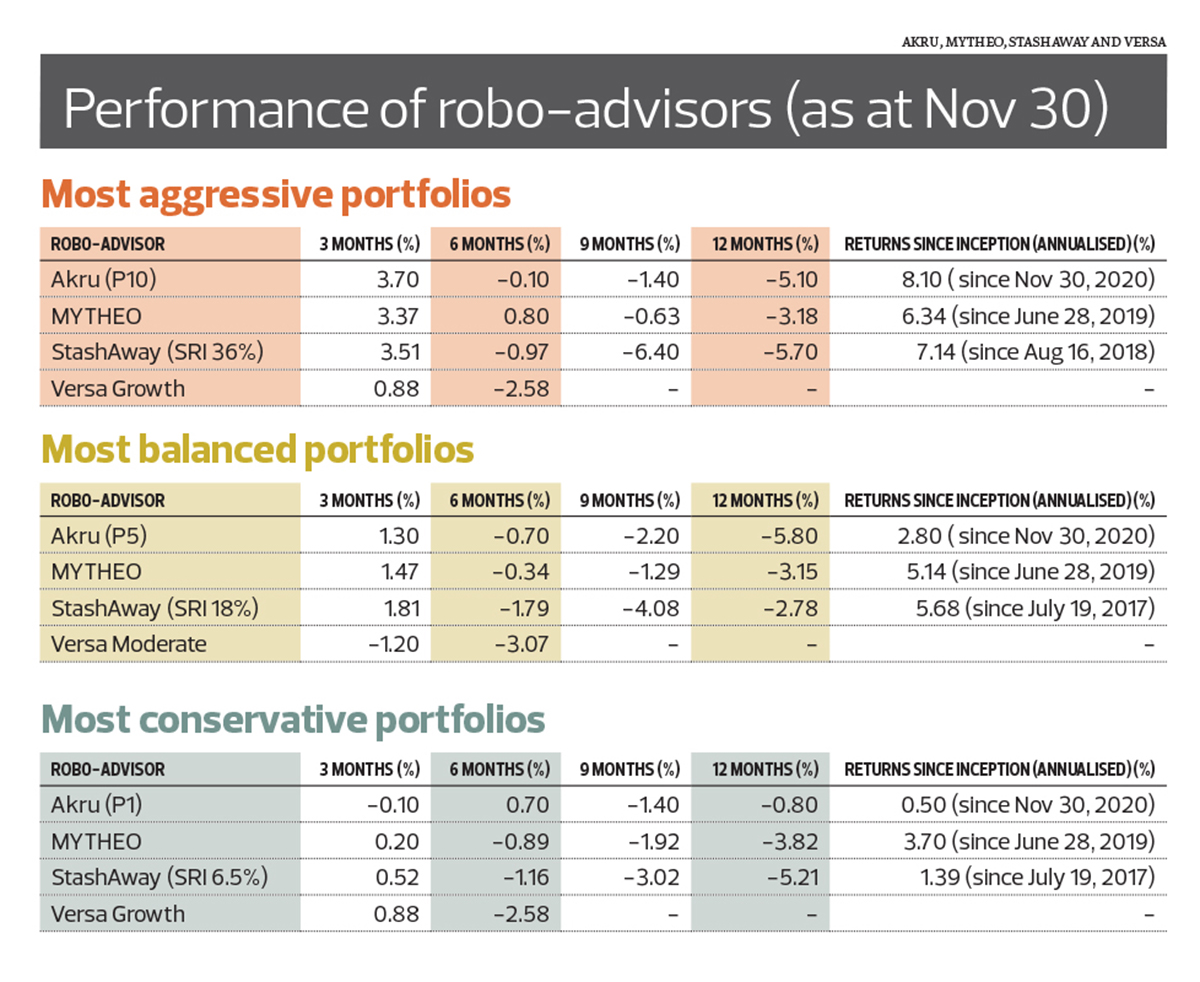
This article first appeared in Wealth, The Edge Malaysia Weekly on December 26, 2022 - January 1, 2023
The question of whether active or passive investing is the superior approach has been asked since the launch of Betterment — the first robo-advisor in the US — in 2008. The discourse carries on to this day, with many supporters at each end of the spectrum.
Various reports have shown that passive investing has done well in developed countries but many fund managers in emerging markets, who pick and trade stocks based on their research, have done better.
The rapid pace of technological advancements, especially machine learning and big data, which can recognise past patterns and predict future trends, is another reason that some believe passive investing, which is often underpinned by computer algorithms, will prevail in the long run.
So, how do local robo-advisors, otherwise known as digital investment managers (DIMs), stack up against their active peers since emerging on the local scene in 2018? Like their peers overseas, DIMs are online platforms that invest globally through exchange-traded funds (ETFs) and make investment decisions using algorithms.
For most fund managers, 2022 has been a rough year. Equity and bond prices fell on the back of spiralling inflation and aggressive interest rate hikes not seen in decades. Gold prices ended the year flat and cryptocurrencies took a nosedive.
Like most actively managed unit trust funds, the portfolios of digital investment managers (DIMs), or robo-advisory firms, are also ending the year in the red. But the performance of DIMs seems to have held up better, based on a comparison against the Lipper Fund Table data as at Nov 30. They have also generated annualised returns of 6.34% to 8.1% since inception, which is considered decent.
DIM operators are optimistic that their solutions will gain better traction among investors as more people understand how low-cost passive investing can benefit them financially in the long run. Another key catalyst is the launch of digital banks that is expected to happen late next year.
Four DIMs — Akru, MYTHEO, StashAway and Versa — have agreed to share the performance of their most aggressive, balanced and conservative portfolios with Wealth. However, please note that it is not an apple-to-apple comparison as the DIMs use different parameters to construct their portfolios. For instance, the most aggressive portfolios of Akru and StashAway invest 95% of their cash in equities, whereas that of MYTHEO only invests about 65%.
The comparison between the performance of the DIMs’ portfolios and that of actively managed unit trust funds is also not apple-to-apple. For one, the performance of the DIMs’ portfolios is at Nov 30, but that of the unit trust funds is until Dec 2, based on the Lipper Fund Table available to Wealth.
Meanwhile, the unit trust funds under the Equity Global category of the Lipper Fund Table are a mixed bag as they focus on various sectors, from commodities to technology. So naturally, the funds that invested heavily in commodities would have done better in general than those that bet on tech stocks this year, as central banks hiked interest rates at a pace unseen in more than a decade.
DIMs’ portfolios in the red, but outperform most of their active peers
According to data provided by three DIMs, their most aggressive portfolios had suffered a loss of between 3.18% and 5.7% as at Nov 30. MYTHEO’s portfolio had fallen 3.18% while that of Akru and StashAway had declined 5.1% and 5.7% respectively. After deducting the maximum rate of annual management fee for each DIM, their net loss stood at 4.18%, 5.8% and 6.5% respectively.
How do they stack up against the 51 actively managed unit trust funds under the non-Islamic Equity Global category of the Lipper Fund Table?
As at Dec 2, the average 12-month performance of the unit trust funds under the non-Islamic Equity Global category was -16.94% after deducting the annual management fee but not the sales charge, which can go as high as 5% for some individual funds. The average net loss of these funds would be -18.84% after deducting the average sales charge.
According to the Federation of Investment Managers Malaysia (FIMM) 2021 Research on Unit Trust Schemes’ Fees and Charges report, the sales charge of unit trust funds dropped to 1.9% on average in 2020 for those who invested in these products in cash.
From a ranking perspective, Akru’s most aggressive portfolio would come in at No 5 in the aforementioned category. It would be the same for the portfolios of MYTHEO and StashAway if they were slotted in individually.
For the actively managed unit trust funds, only three generated a positive return this year (as at Dec 2) — Manulife Global Resources (22.78%), AmGlobal Agribusiness (13.32%) and United Global Durable Equity USD (4.18%). Their returns would still be in positive territory after deducting the average sales charge of 1.9%. The only unit trust fund in this category that suffered a slight loss was Manulife Global Low Volatility Equity A USD (-2.11%), which was ranked No 4.
Over the longer term, the most aggressive portfolio of Akru had provided investors with an annualised return of 8.1% since its inception on Nov 30, 2020, while that of MYTHEO had generated a return of 6.34% since its inception on June 28, 2019. StashAway’s most aggressive portfolio had provided investors with an annualised return of 7.14% since its inception on Aug 16, 2018.
Versa, a licensed online distributor of investment products, launched its growth portfolio that invests in exchange-traded funds (ETFs) and actively managed unit trust funds in May and, hence, did not have a one-year historical performance at the time of writing. Versa Growth, its most aggressive portfolio, was in the red at -2.58% on Nov 30, excluding its annual management fee of 1%.
Where do the returns and losses come from?
Tan Hui Koon, director and chief investment officer at Akru, says its most aggressive P10 portfolio invests in five ETFs. On the equity side, three ETFs track the US equity market, developed market equities ex-US and emerging market equities. On the bond side, two ETFs track the movements of US bonds and international bonds.
The firm has not undertaken any re-optimisation exercises for its portfolio since inception, which means it has not replaced any of the ETFs to focus on other asset classes, themes, regions or countries beyond its current investment universe.
As at Nov 30, its ETFs were down by 9.21% to 16.97% over the last 12 months, says Hui Koon. However, the downside was shielded by a weakening ringgit against the US dollar.
She says this has been a challenging year for fund managers. “2022 has been an exceptional year, when the correlation between the S&P 500 and the US 10-year Treasury became positive. From 1928 to 2022, it has only happened four times — in 1931, 1941, 1969 and 2022.”
As for its annualised return of 8.1% since inception, it was mainly derived from the US markets and ringgit depreciation against the US dollar.
While Akru has the least number of ETFs in its portfolio compared to its peers, the five funds invested in more than 20,000 securities across the globe, which is very diversified, says Hui Koon.
Ronnie Tan, CEO of GAX MD Sdn Bhd, which operates MYTHEO, takes pride in the firm’s portfolios as being the most diversified and stable among its peers, with each of them consisting of 20 to 30 ETFs.
While its most aggressive portfolio was down 3.18% over the last 12 months, there were bright spots. Among them were ETFs that track the overall performance of the energy, infrastructure and precious metal sectors. ETFs that track value stocks in equity markets, such as those in India, Australia, the UK and the US, had done well too, as well as those with exposure to shorter-duration high-yield bonds.
On the flip side, the ETFs that dragged its overall 12-month performance into the red were US Growth ETFs, especially those that track large-cap companies, and China ETFs. Long-duration bond ETFs, such as those that track the US 20-year Treasury, were also down, says Ronnie.
MYTHEO has not “reconstructed” its portfolios since its inception in 2019, which means the firm has not removed any of the existing ETFs in its current investment universe and replaced them with new ETFs.
StashAway is perhaps the most active player in the DIM space with more than 10 ETFs in its general investing portfolios. Wong Wai Ken, its country manager for Malaysia, says the firm has done two re-optimisation exercises this year alone.
In January, it re-optimised its portfolios in view of an inflationary growth environment for non-US economies. The major theme for its first re-optimisation exercise was to maintain effective inflation protection while keeping valuations in mind.
“We adjusted our inflation hedges by reducing allocation to developed- and emerging-market government bonds, in favour of high-quality US corporate bonds and inflation-linked government bonds. We also reduced our allocation to the US consumer staples, US REITs and slightly in US energy due to their high valuations. We were in favour of high allocations to US small-cap and financial stocks,” says Wong.
The second re-optimisation exercise took place in March. The major theme was to remove KWEB, or KraneShares CSI China ETF, in times of geopolitical uncertainty.
“We removed KWEB to better manage the risk of secondary sanctions [imposed by the US] on China due to the Russia-Ukraine war. We allocated assets to regions with minimal direct exposure to sanction risk while maintaining inflation protection. This was done by increasing our exposure to Australian and Japanese equities, international treasury bonds and international inflation-linked bonds,” says Wong.
In the past 12 months, energy equities were the biggest source of support for StashAway’s portfolio. The bulk of its losses came from its allocation to Chinese technology stocks, on the back of Beijing’s regulatory crackdown and geopolitical tensions between the US and China.
Meanwhile, the main contributors to StashAway’s annualised return of 7.14% since Aug 16, 2018, were US consumer discretionary, small-cap and healthcare stocks. Energy equities have been outperforming other asset classes recently as well, he says.
Versa’s investment portfolios are managed by AHAM Capital (previously known as Affin Hwang Asset Management Bhd). The latter says the cash or money market has been the biggest contributor to its portfolio, as both bonds and equities fell in the past six months. Its exposure to Malaysian equities and fixed income also generated positive returns.
The biggest drag on its portfolio was its exposure to Asian markets, in particular China. Its investments in the European market have also underperformed. Nevertheless, both of these have seen a significant rebound since October, says AHAM Capital.
Save by subscribing to us for your print and/or digital copy.
P/S: The Edge is also available on Apple's App Store and Android's Google Play.
- Tariff shock awaits China after trade surplus hits US$103 bil
- Malaysian semiconductor stocks fall amid US probes, software firms steady
- Maybank customers can now make QR payments through MAE app in Cambodia
- HRD Corp's chief executive Shahul Hameed steps down, confirming The Edge report
- Farewell, Pak Lah
- Apple fuels stock market rebound as Trump says he helped Cook
- U Mobile to roll out Malaysia’s second 5G network with Huawei and ZTE
- Prime Penang properties worth up to RM400 mil for sale
- Frankly Speaking: Fear spreads to IPO market
- MIDF says Life Water sailing with margin tailwinds as packaging cost eases; initiates coverage with 'buy'



